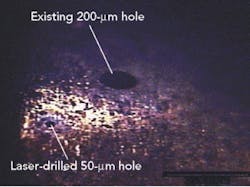Two laser techniques can lower friction losses, reduce emissions levels, and improve fuel efficiency
Automotive manufacturers are tasked with developing engines that meet increasingly stringent regulations relating to emissions and fuel efficiency, while simultaneously attempting to satisfy the demand for higher performance (i.e., higher power). In the U.S., for example, automobiles not only have to pass ever-stricter smog standards, but also the Corporate Average Fuel Economy (CAFE) standards put an ever-increasing emphasis on fuel economy. In this article, we discuss two techniques that can help automotive engine manufacturers move closer to these goals—laser texturing of cylinder liners and precision drilling of fuel injector nozzles. We also present data from durability tests on diesel engines at Audi that indicate the laser treatment of cylinder liners can dramatically reduce frictional wear by up to 89%, and reduce oil consumption by as much as 75%.
Diesels and mechanical wear
The low fuel consumption of diesel engines has made these engines very popular in a wide range of vehicles outside the U.S., from compact cars to heavy trucks. But the diesel engine has not yet gained widespread popularity in the U.S. for private automobiles, mostly due to the misperception that it delivers lower performance than a gasoline engine. Plus, places such as California must contend with the additional problem of a lack of low-sulfur diesel fuel.
Diesel engines require higher compression ratios (up to 30:1) than gasoline engines to ignite the fuel with no spark plug. For this reason, even lightweight diesel engines use cast iron cylinder liners to withstand high mechanical stresses. This high compression makes piston ring/cylinder wear and friction more pronounced, limiting the performance of current diesel engines and constraining the ability to improve engine performance. For example, one simple way to increase diesel engine performance is to raise the compression ratio even higher. But this has limited possibilities at present because of friction, sealing, and wear issues at the ring/cylinder liner interface.
How big a problem is ring/liner friction? In an internal combustion engine, most of the combustion energy is lost as heat to the cooling system. Of the remaining available power, around 15% goes to mechanical losses due to friction in the engine and drive train. In a diesel engine, up to 60% of these mechanical losses result from friction between the piston rings and cylinder walls. Consequently, it has been estimated that reducing this frictional loss by even 10% can lead to a decrease in fuel consumption of up to 3%. In today's world of small incremental improvements in engine efficiency, 3% is a very significant gain. In the long term, this friction also causes wear to the rings and cylinder liners, reducing engine performance, increasing emissions, and raising oil consumption.
Advances in laser surface treatment
Although carbon-dioxide lasers have been used since the early 1970s to harden cast iron cylinder liners, until now, no one has used high-energy ultraviolet (UV) laser pulses for large-area treatment of cylinder liners. At Audi, we have conducted extensive studies on the effects of UV laser surface treatment using a four-cylinder, 1.9-liter (81 kW) Turbo Direct Injection (TDI) diesel engine. We also performed additional studies on a V6 diesel engine. We fabricated the cylinder liners and mounted them in the usual (industry-standard) manner before conducting the laser surface test studies. The only difference was that we substituted the laser surface treatment for the final mechanical polishing (honing) step.
To perform the surface treatment, we positioned the engine block in a purpose-built workstation incorporating a high-pulse-energy excimer laser—the Lambda Physik Lambda Steel 1000—operated at a wavelength of 308 nm with a pulse duration of 25 ns. This laser produces 1 joule/pulse with a pulse repetition rate of 300Hz. The maximum stabilized average power is 300 watts. In this workstation, the laser beam is directed into the cylinder (within the engine block) by beam delivery optics. The final optic is a turning mirror sitting inside the cylinder that directs the beam at the cylinder liner. The height of this optic is scanned to allow the beam to be scanned along the length of the cylinder wall. Coordinated rotation of the engine block provides circumferential scanning. A nitrogen-assist gas is applied to the cylinder surface during laser irradiation. The scanning system was developed in cooperation with ARGES Industrieplanung und Lasertechnik GmbH, Nabburg (Germany).
We acquired two types of data after treating test cylinder liners in this way. Most important, we conducted extensive lifetime and durability tests. We ran the four-cylinder TDI engines on dynamic test beds for 602 hours using standard endurance protocols designed to simulate multiple duty cycles: variable engine revs at full load endurance; variable engine revs/variable load; full load/low load; and start/stop.
We monitored engine performance throughout these tests. We also took SEM micrographs to examine the surface topography of laser-treated cylinders at the microscopic scale. In addition, we took a section from the upper part of one of the cylinders from a TDI engine after 800 hours of running time. We analyzed this cross-section using TEM microscopy.
Reduced wear-tribological explanation
The results from the TDI engine endurance tests were very dramatic, as shown in Figure 1. Compared to mechanically honed cylinder liners, the wear to the cylinder walls was reduced by 23% to 89%, depending on the duty cycle. Corresponding wear to the piston rings was reduced by 30% to 88%. In the case of the V6 engine, oil consumption was reduced by 75% during an 800-hour test.
The SEM and TEM micrographs suggest that these dramatic engine improvements are due to three laser-induced phenomena: surface hardening, surface smoothing, and oil retention due to surface modification.
The TEM microscopy data indicates that use of the excimer laser and nitrogen-assist gas creates a surface layer of a very hard material, resembling a nitride. Even after 800 hours, TEM data indicated the presence of this material on the liner surface. It also indicated the presence of a fine-grained iron structure containing both carbon and nitrogen. This data appears to confirm the supposition that the ultraviolet laser causes both chemical transformation and micron-scale hardening. The TEM data also confirms that the laser-induced annealing serves to smooth the outer surface. Specifically, honing causes some smearing and bulging of graphite lamellae in the cast iron surface. The laser process appears to eliminate these surface irregularities.
Although the combination of a harder and smoother surface definitely reduces both friction and wear, we believe a surface modification effect also plays a major tribological role in the observed dramatic results. Figure 2 shows SEM images of liner surfaces after conventional mechanical honing, and after laser treatment. Honing causes a random pattern of crisscrossed, interlinked surface grooves, which serve to trap oil. However, these grooves can act as a connected system of channels, permitting the pressure and motion of the piston ring to push the oil out of the way, allowing asperity (sharp metal-on-metal) contact.
The laser treatment opens up the preexisting graphite lamellae so that the surface contains many microscopic pits or wells that serve to trap oil. As these are not interconnected, the oil has no way to escape and the piston ring hydroplanes on the trapped oil droplets, as shown in Figure 3. Obviously, this condition is much closer to the ideal goal of elasto-hydrodynamic (full fluid) lubrication. Pit size is critical; the pits must be large enough to enable the effect, while not so large as to allow any "blow-by." The precise pit dimensions are proprietary to Audi.
Drilling fuel injector nozzles
We also are in the early stages of developing new laser-drilling processes to target another aspect of diesel engine efficiency—namely, the fuel injection process.
Ideally, fuel injectors should uniformly fill the engine cylinder with a fine aerosol of diesel fuel. This is achieved by forcing the pressurized fuel through tiny holes in the injector tip, which is fabricated from hardened steel with a typical thickness of 1mm. Traditionally, these holes have been created by electrical discharge machining (EDM). A typical injector nozzle has up to 12 holes with diameters generally in the range of 150-200 microns.
Recently, the United States Environmental Protection Agency mandated that the diesel industry must meet stricter fuel efficiency standards by 2007 and even stricter requirements by 2010. In addition, the allowable levels of soot and NOx must be reduced to 90% of 1988 levels. Meeting these goals requires improving combustion efficiency, which in turn requires redesigning injector nozzles to deliver smaller droplet sizes. Specifically, both smaller hole diameters (as small as 50 microns) and increased tip thickness are being explored. The latter is necessary to withstand the higher pressure required to force fuel through these small holes. In addition, exotic hole shapes also are being investigated, most notably holes with reverse taper. All these characteristics present virtually impossible difficulties for the EDM method, but not for lasers.
Fine-hole drilling ideally requires a laser beam with a TEM00 profile that can easily be focused to a small spot diameter. The hole is then created by either percussion drilling, whereby the hole diameter equals the beam diameter, or by helical drilling, whereby a small beam is scanned in a spiral shape, essentially trepanning the hole. We believe both methods might ultimately find use in this application. Percussion drilling is simpler, costs less to implement, and can deliver speeds of less than 0.5 sec/hole. But with appropriate focusing optics and careful control of the tip/beam motion (see ILS, July 2004, page 16), helical drilling allows the creation of holes with a reverse taper and/or custom profiles.
High-peak-power, high-beam-quality pulsed lasers are required for this application because they produce clean holes with minimum debris. Fortunately, diode-pumped all-solid-state lasers with TEM00 beam characteristics are now well established as reliable, industrial-grade tools in other precision drilling applications—e.g., for drilling microvias in the microelectronics industry. Moreover, they are simple to integrate because of their compact size and low utilities consumption.
Although this application is in the early stages of development, we already have achieved some striking results. Figure 4 shows a typical sample and compares a 200-micron hole created by the EDM process and a smooth 50-micron diameter hole created by helical laser drilling. The laser scanning system used to drill this hole was developed in cooperation with Arges Industrieplanung und Lasertechnik GmbH, Nabburg (Germany).
Conclusion
Lasers have a long history in the automotive industry, primarily for welding and cutting applications, in which they reduce the cost of manufacturing. Now, new laser techniques are being developed that will help the automotive industry meet the growing demand for "greener" engines that simultaneously deliver higher performance.
Ludolf Herbst, Lambda Physik AG, Göttingen, Germany; Horst Lindner, Audi AG, Ingolstadt, Germany; Mike Heglin, Lambda Physik, Ft. Lauderdale, FL; and Tony Hoult, Coherent, Inc., Santa Clara, CA. Email: [email protected], www.lambdaphysik.com.






